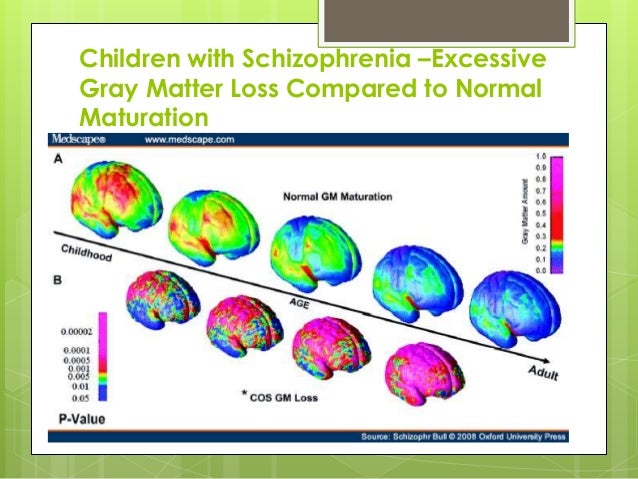IDEA Schizophrenia for a large portion of the world population is thought to be a very dangerous psychological condition that occurs when people “lose their noodle” or “go crazy”. For the most part, they are not entirely wrong, however, schizophrenia develops a lot more from a biological point of view than what people know.
DIAGNOSIS according to the DSM-V (Diagnosis book used by mental illness diagnosticians), the diagnosis of schizophrenia must have at least two of the following symptoms: Hallucinations, Delusions, Disorganized speech, Disorganized behavior, Poverty of speech, Decrease emotional range, loss of interest and drive, or tremendous inertia (skeptical about change).
BRAIN Now that the psychological aspect has been laid out, lets delve deeper into the behind the brain scenes. Evidence of damaged or underdeveloped prefrontal cortex of the brain leads to the disorganized thinking, along with psychosis due to the excess release of dopamine. An fMRI study using 18 schizophrenic patients and 19 normal control individuals was done in order to compare the activation of the prefrontal cortex and the substantia nigra/ventral tegmental area (responsible for dopamine release). It was found that the activation in the schizophrenic’s prefrontal cortex was significantly less than normal, along with the increase of dopamine being confirmed from the substantia nigra/ventral tegmental area.
WHY?
The reason behind these brain changes is due to loss of neuron connectivity from the cerebellum to the amygdala, or the amygdala to the prefrontal cortex (not confirmed where along this line connections are not forming). with these connections not being formed, this slows neural plasticity in the brain, and keeps connections from strengthening during brain development stages (ages 0-25). with these connections that are missing, this allows neurons from other pathways to form and create connections in areas that they are not supposed to. This explains why a majority of schizophrenic patients that are diagnosed are before the age of 25. Since these connections are not being formed and strengthening by growth, the normal brain size for a schizophrenic is smaller than that of a normal human brain.

The growth factor that is being found disrupted and preventing this neuronal growth is the neural growth factor Wnt. The purpose of Wnt is to control for embryonic development of the brain, along with adult homeostasis. When this development is disrupted, certain brain connections are not maintained.

Despite this early on indicator that can be found as early as post-natal age, environmental factors still play a role in the development of a diagnosable schizophrenia condition. Birth trauma and maternal stress are known to be prenatal factors in developing schizophrenia. early parental loss or poor mothering during childhood is also known to associate with Schizophrenia. as individuals grow older however, outside stress (school, job, peer, etc.) and drug abuse is highly associated with developing schizophrenia.
OVERALL Schizophrenia is a mental disorder that occurs due to underdevelopment of neuronal pathways b the Wnt pathway that control for emotional organization and memory association. The severity of the condition is determined but the type and amount of environmental conditions involved. Just because you show early signs of schizophrenia (smaller brain, less activation of prefrontal cortex, increased dopamine release) does not mean you will develop schizophrenia, rather it may just show risk or slight impairment in these regions (not a diagnosable condition).
By: Alex Faber
RESOURCES:
- http://emedicine.medscape.com/article/288259-overview
- https://www.nimh.nih.gov/news/science-news/2013/mapping-brain-circuits-provides-clues-to-schizophrenia-earlier-detection-of-psychosis.shtml
- https://image.slidesharecdn.com/shizophrenia-130129213838-phpapp01/95/schizophrenia-past-present-and-future-20-638.jpg?cb=1359636235
- https://moodle.cord.edu/pluginfile.php/625277/mod_resource/content/2/2013%20wnt%20GSK%20and%20schizophrenia.pdf
- https://img.webmd.com/dtmcms/live/webmd/consumer_assets/site_images/article_thumbnails/reference_guide/7_questions_about_your_newborn_babys_first_week_ref_guide/493x335_7_questions_about_your_newborn_babys_first_week_ref_guide.jpg?resize=400px:*&output-quality=50